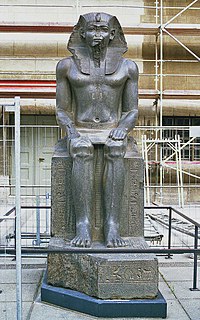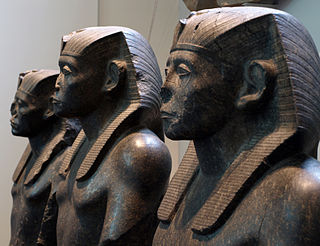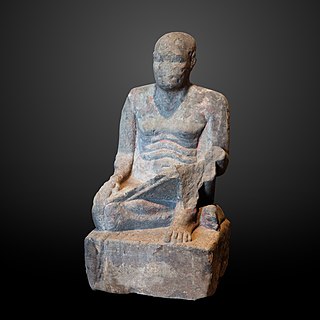Related Research Articles

Saqqara, also spelled Sakkara or Saccara in English, is a vast, ancient burial ground in Egypt, serving as the necropolis for the ancient Egyptian capital, Memphis. Saqqara contains numerous pyramids, including the world-famous Step pyramid of Djoser, sometimes referred to as the Step Tomb, and a number of mastaba tombs. Located some 30 km (19 mi) south of modern-day Cairo, Saqqara covers an area of around 7 by 1.5 km.

Amenemhat III, also spelled Amenemhet III, was a pharaoh of the Twelfth Dynasty of Egypt. He ruled from c. 1860 BC to c. 1814 BC, the highest known date being found in a papyrus dated to Regnal Year 46, I Akhet 22 of his rule. His reign is regarded as the golden age of the Middle Kingdom. He may have had a long coregency with his father, Senusret III.

Dahshur is a royal necropolis located in the desert on the west bank of the Nile approximately 40 kilometres (25 mi) south of Cairo. It is known chiefly for several pyramids, two of which are among the oldest, largest and best preserved in Egypt, built from 2613 to 2589 BC.

The Egyptian pyramids are ancient pyramid-shaped masonry structures located in Egypt. As of November 2008, sources cite either 118 or 138 as the number of identified Egyptian pyramids. Most were built as tombs for the country's pharaohs and their consorts during the Old and Middle Kingdom periods.

Amenemhat I also Amenemhet I and the hellenized form Ammenemes, was the first ruler of the Twelfth Dynasty, the dynasty considered to be the golden-age of the Middle Kingdom of Egypt. He ruled from 1991 BC to 1962 BC.

Nubkaure Amenemhat II was the third pharaoh of the 12th Dynasty of ancient Egypt. Although he ruled for at least 35 years, his reign is rather obscure, as well as his family relationships.

Khakaure Senusret III was a pharaoh of Egypt. He ruled from 1878 BC to 1839 BC during a time of great power and prosperity, and was the fifth king of the Twelfth Dynasty of the Middle Kingdom. He was a great pharaoh of the Twelfth Dynasty and is considered to be, perhaps, the most powerful Egyptian ruler of the dynasty. Consequently, he is regarded as one of the sources for the legend about Sesostris. His military campaigns gave rise to an era of peace and economic prosperity that reduced the power of regional rulers and led to a revival in craftwork, trade, and urban development. Senusret III was among the few Egyptian kings who were deified and honored with a cult during their own lifetime.

Khnumhotep III was an ancient Egyptian high steward and vizier of the 12th Dynasty.
Neferthenut was an ancient Egyptian queen of the Twelfth Dynasty of Egypt. She was most likely the wife of Senusret III.

Mentuhotep was an ancient Egyptian official and treasurer under the 12th Dynasty pharaoh Senusret I. Mentuhotep is one of the best attested officials of the Middle Kingdom period. There is a series of statues found at Karnak, showing him as a scribe. On these he has been given the title of overseer of all royal works, which would suggest that he was involved in overseeing the construction of the temple at Karnak. At el-Lisht he had a large tomb next to the pyramid of Senusret I. When it was found it was badly damaged, but there are remains of high quality reliefs and fragments of statues. The burial chamber still contained two sarcophagi, one smashed and the other one well preserved, made of granite and with brightly painted interiors.
Senusret was an Ancient Egyptian official who was a vizier during the last years of king Senusret I's rule and in the first years of Amenemhat II. Senusret is known from a stela found in Abydos, which is dated to year 8 of Amenemhat II. He also appears in biographical inscriptions in the tomb of the governor Amenemhat at Beni Hasan, where it is stated that he was on a mission to Koptos. The inscription reports events under Senusret I.
Neferu was an ancient Egyptian queen of the 12th Dynasty. She was a daughter of Amenemhat I, sister-wife of Senusret I and the mother of Amenemhat II.

Khenemetneferhedjet I Weret was an ancient Egyptian queen of the 12th Dynasty, a wife of Senusret II and the mother of Senusret III.

Siese was a vizier and treasurer of the Twelfth Dynasty of Egypt. He was most likely in office under Senusret III.
Nebit was an ancient Egyptian official during the reign of king Senusret III. He held the position of vizier. Thus, he was the most important official at the royal court. Nebit is only known from his large mastaba, which was excavated next to the pyramid of the king at Dahshur. The mastaba was built of mud bricks and then covered with stones. Already in ancient times the high quality stone was looted and used for other building projects or just for burning lime. However, one wall of the mastaba facade had already collapsed and had been covered by sand before looters dismantled the rest of the building. The preserved facade bears the name and title of Nebit, but also the name of the king. Within the remains of the mastaba were found by Jacques de Morgan the bust of a statue made of granodiorite. The fragment is not inscribed but most likely depicts Nebit.
This page list topics related to ancient Egypt.

Itakayt was an ancient Egyptian princess and queen of the 12th Dynasty, around 1800 BC. She is mainly known from her small pyramid next to the one of Senusret III at Dahshur. She had the titles king's daughter of his body, powerful, graceful and beloved.
Menet was an ancient Egyptian king's daughter living in the Twelfth Dynasty most likely under the kings Senusret III and Amenemhat III. Menet had the titles king's daughter and the one united with the white crown (Khenemetneferhedjet). She is only known from her sarcophagus and burial in a gallery tomb buried with other members of the royal family next to the pyramid of Senusret III at Dahshur. From the position of the tomb it seems likely that she was the daughter of the latter king.

The Pyramid of Senusret III is an ancient Egyptian pyramid located at Dahshur and built for pharaoh Senusret III of the 12th Dynasty.
Horkherty was an Anient Egyptian official of the Twelfth Dynasty under king Senusret III. Horakhty is so far only known from his mastaba found next to the pyramid of the king at Dahshur. North of the Pyramid of Senusret III at Dahshur is a small cemetery belonging to officials serving under the king. The largest tomb there belongs to the treasurer Sobekemhat, a slightly smaller mastaba right next to this one belongs to the vizier Nebit. A thitd big mastaba belonged to Horakhty. The mastaba is not well preserved. His titles include royal sealer and king's acquaintance. Within his mastaba complex was found the unlooted burial of a woman called Sitwerut, perhaps the wife of Horkherty.
References
- ↑ Adela Oppenheim: Identifying artists in the time of Senusret III. The mastaba of the vizir Nebit (North Mastaba 18) at Dahshur, in M. Barta, F. Coppens, and J. Krejčŕ (editors), Abusir und Saqqara in the Year 2005, Prague 2006, 123, note 28